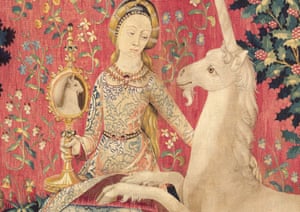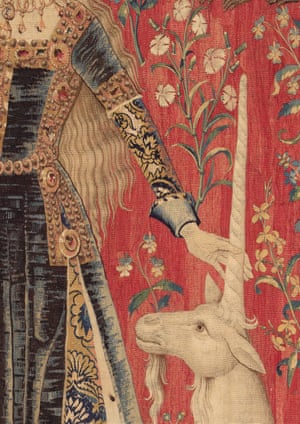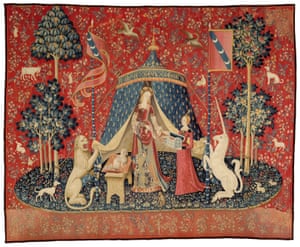The tapestries on display at the Art Gallery of NSW have appeared in everything from the writings of George Sand to those of the poet Rainer Maria Rilke.
For a mythical creature that is supposedly very shy, the unicorn sure is getting around. The white horse with a long horn and Bambi eyes is popping up everywhere from decal on children’s backpacks to T-shirts, key rings, flags, toys and tattoos, often accompanied by a little rainbow. The unicorn aesthetic has dominated music videos for the last few years. It’s been borrowed for queer raves and even as a descriptor for (usually) women who are the third party joining a couple in bed. These creatures – the mythical animals, that is – are nothing if not versatile: they’ve even been used in art as stand-ins for Jesus Christ.
Now, the Art Gallery of NSW is holding an exhibition of arguably the most famous piece of medieval art featuring the creature. The Lady and the Unicorn is a series of six massive wall-length tapestries that feature a medieval lady in a garden, sometimes accompanied by her handmaid, but always hanging out with a unicorn.
The series, commissioned by a noble French family in the 1500s and created by unknown weavers, has been called everything from the Mona Lisa of the middle ages to a national treasure of France. The priceless works of art, which have been restored several times, have appeared in everything from the writings of George Sand to poet Rainer Maria Rilke. Facsimiles of them feature in the Harry Potter movies, hanging on the walls of the Gryffindor common room. They have also been seen in Jean Cocteau’s drawings, sets and costumes for the Ballet Russes. They inspired Tracy Chevalier’s novel, Lady and the Unicorn, and Charlotte Wood’s The Natural Way of Things.
To get to Australia, the tapestries each flew in a separate plane – in case of a crash. Photograph: RMN-Grand Palais-Michel Urtado
The tapestries’ usual home is the Musée de Cluny in Paris and it is rare to get a glimpse of them outside France. They were acquired by the Cluny in 1882 after they had been hung in a municipal city hall. Previously, they were housed in the Château de Boussac – a crumbling place where they were left to moulder. Over the course of several centuries they were exposed to damp and to rats, and rumours abound that the owners had cut them up for horse cart coverings and a foot rug. (Sand stayed in that chateau and became entranced with the tapestries. Her writing about The Lady and Unicorn was the start of a movement to acquire and restore them.) During the second world war, the tapestries were removed from Paris, in case they were looted or destroyed by the Nazis. They were holed up in another chateau in the middle of a forest until after the war.
The ‘touch’ tapestry. Photograph: RMN-Grand Palais-Michel Urtado
To get to Australia, the tapestries each flew in a separate plane – like the royal family – in case of a crash. They were draped over a stand-in a crate and, when they landed in Sydney, a whole team of curators from the Cluny were there to supervise their hanging.
The tapestries are remarkably robust for works so old but care must still be taken. Recently, they were painstakingly cleaned using a super-fine mist.
The tapestries depict one of the five senses – touch, taste, smell, sound and sight – plus one extra titled Mon Seul Désir, or “My Sole Desire”.
Béatrice de Chancel-Bardelot, curator at Musée de Cluny, says the weavers who created the works were probably men from a local guild, and that creating the six tapestries would have kept them busy for several years. The family that commissioned the work was based in Lyon and had houses in Paris and a castle in Burgundy. “They were active in commissioning major works of art,” says De Chancel-Bardelot, and were as likely as rich as Medusa.
Yet the artistic philosophy behind the works remains a mystery. For example, who is the lady? What is the significance of the unicorn? Why is it paired with a lion?
The Art Gallery of NSW special exhibitions curator, Jackie Dunn, says the works remains enigmatic despite years of scholarship devoted to their story and origin. “Some people read the unicorn as a stand-in for a lover, in a take on courtly love. In medieval times it was also a stand-in for Christ.”
In medieval times, people believed unicorns were real, Dunn says. In art they were depicted in brown “and looked like camels” while in Germany they were blue. “Everyone believed in them. Travellers came back to Europe – like Marco Polo – having reported seeing them in Jerusalem, in the deserts of the Middle East.”
Mon Seul Désir – or My Sole Desire – the most debated and discussed tapestry of the collection. Photograph: RMN-Grand Palais-Michel Urtado
Walking through the gallery housing the tapestries late last week was akin to visiting a chapel, with each tapestry reminiscent of a station of the cross. They are thick and substantial, giving the acoustics of the room a hush. They are immensely rich in detail and feature many aspects of the natural world, including hollybush and bluebells (one scholar has counted forty species of plants), as well as birds and domestic and wild animals. All are in harmony.
There is something of the Garden of Eden in the work: everything is in its rightful place. Maybe that’s why viewers are so drawn in. The peacefulness of the works radiates through time and space. To look at them is a kind of meditation.














